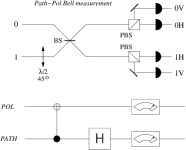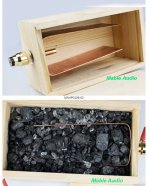It is easy to scoff when we have no direct experience of the quantum world.
The quantum world keeps getting bigger. A recent experiment on crystals made from 10 billion atoms proves that even large objects follow the weird rules of quantum mechanics.
Vibrating crystal made of 10 billion atoms smashes quantum record | New Scientist
A ground box may function on the principle of quantum entanglement whereby the properties of the electrons within the chassis of the connected equipment are linked with the properties of those within the ground box crystals.
If the owner determines that the crystals within the ground box have a measurable state of stability then, by some spooky action at a distance, that stability will be transferred to the electrons within the equipment chassis.
Bell's Theorem provides a standard test for the existance of entanglement, as outlined in the attached diagram where H represents the ground box and BS represents the Bull **** detector.
The quantum world keeps getting bigger. A recent experiment on crystals made from 10 billion atoms proves that even large objects follow the weird rules of quantum mechanics.
Vibrating crystal made of 10 billion atoms smashes quantum record | New Scientist
A ground box may function on the principle of quantum entanglement whereby the properties of the electrons within the chassis of the connected equipment are linked with the properties of those within the ground box crystals.
If the owner determines that the crystals within the ground box have a measurable state of stability then, by some spooky action at a distance, that stability will be transferred to the electrons within the equipment chassis.
Bell's Theorem provides a standard test for the existance of entanglement, as outlined in the attached diagram where H represents the ground box and BS represents the Bull **** detector.
Attachments
well if quatum entanglement is happening are we to worry that alien audiophiles will use "ground boxes" and pollute our audio grounds? it may be the catalyst for intergalactic war!!
Original article contains dirt from a specific region in Romania.Not all of them contain dirt, so not all may be useful as planters. Some may be useful for indoor cats to use.

Back in '89, I was working for a mfr in the LA area; on April 1st, a well know company that makes anti-static equipment (AS mats for benches, wrist straps for techs, AS trays for ICs, etc.), circulated a nice glossy data sheet for a "portable ground device", complete with some slick photos and bullet points for all the benefits. It was a 1 pint mason jar filled with dirt, a metal probe sunk into it and a coiled cord with alligator clip attached. You had your choice of where the dirt came from (Arkansas, Kentucky, Tennessee etc.).
They had another glossy data sheet for a "Static Stake" for grounding the technician to his bench area, which was essentially a chrome plated tent stake about a foot long; you drove the "Static Stake" through the tech's foot and into the ground. One of the added benefits they claimed was that it stopped technicians from wandering off during working hours.
Maybe someone took them seriously and started their own company to make competing products?
They had another glossy data sheet for a "Static Stake" for grounding the technician to his bench area, which was essentially a chrome plated tent stake about a foot long; you drove the "Static Stake" through the tech's foot and into the ground. One of the added benefits they claimed was that it stopped technicians from wandering off during working hours.
Maybe someone took them seriously and started their own company to make competing products?
Avoid the worthless fake, will not ground and rejuvenate your treasured vampire properly. 😀... You had your choice of where the dirt came from (Arkansas, Kentucky, Tennessee etc.)....
From this specific region:
Buffalo chips are the new endangered feces !
From the Grounding Box user guide: (yes, there are instructions)
"Note.Put Feets under your boxes will improve the result. "
Doesn't this mean you are raising the ground potential though..?
"Note.Put Feets under your boxes will improve the result. "
Doesn't this mean you are raising the ground potential though..?
Even better, you could suspend the box by hanging it from a helium baloon, which would make it a floating ground.
Ray K
Ray K
I spotted one for sale and decided that I could make one for little more than the cost of a shiny connector. It was just a little coal bunker with a bit of copper in it. I can get plenty of well weathered coal from the leftovers of a local now closed coal mine. There are plenty of pallets about for the wood to make the box.
Attachments
Member
Joined 2009
Paid Member
I remember seeing these boxes a few years back. Rather than dismiss them I thought about the possible benefits - any benefit has some worth to a customer and value-for-money is in the eye of the beholder.
The main benefit I saw was the creation of a system level star ground, which, if done well (key) can clean up ground loops and their relatives. Side benefits include enforcing some discipline in terms of system set up and likely implies the owner will be fussy about it. More contentiously, the owner may feel happy/satsfied, even if it’s a placebo this alone is valid.
It looks like an ideal candidate for DIY. A grounding box needs weight so that it will not get dragged around by the cables, so a box of metal and dirt should work admirably. Good quality connectors which are suitably anchored to each other through low impedance, a chunk of metal serves that need too. I’d want to have a safety earth too, clearly marked as such, perhaps already existing in the system in a commercial box.
The main benefit I saw was the creation of a system level star ground, which, if done well (key) can clean up ground loops and their relatives. Side benefits include enforcing some discipline in terms of system set up and likely implies the owner will be fussy about it. More contentiously, the owner may feel happy/satsfied, even if it’s a placebo this alone is valid.
It looks like an ideal candidate for DIY. A grounding box needs weight so that it will not get dragged around by the cables, so a box of metal and dirt should work admirably. Good quality connectors which are suitably anchored to each other through low impedance, a chunk of metal serves that need too. I’d want to have a safety earth too, clearly marked as such, perhaps already existing in the system in a commercial box.
Last edited:
Ground loops:
Ground Loops
Not exhaustive but if you are wondering about them this will help you get going in the right direction. No grounding boxes are used 😉
It will be updated from time to time.
Ground Loops
Not exhaustive but if you are wondering about them this will help you get going in the right direction. No grounding boxes are used 😉
It will be updated from time to time.
Member
Joined 2009
Paid Member
From a DIY perspective a low cost option for doing your own experiments would be to rescue an old HT receiver or tv box from the e-waste that already has some suitable connectors. Use some thick copper wire to join the connectors together. Seal holes in the box with sonething suitable - duct tape is hand - and add your choice of filler ‘dirt’.
- Status
- Not open for further replies.
- Home
- Member Areas
- The Lounge
- What constitutes a grounding box?




